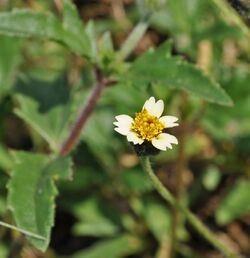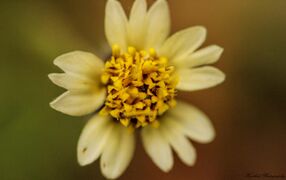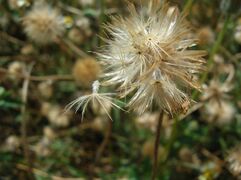Biology:Tridax procumbens
| Tridax procumbens | |
|---|---|

| |
| Scientific classification | |
| Kingdom: | Plantae |
| Clade: | Tracheophytes |
| Clade: | Angiosperms |
| Clade: | Eudicots |
| Clade: | Asterids |
| Order: | Asterales |
| Family: | Asteraceae |
| Genus: | Tridax |
| Species: | T. procumbens
|
| Binomial name | |
| Tridax procumbens | |
| Synonyms[1] | |
| |
Tridax procumbens, commonly known as coatbuttons[2] or tridax daisy, is a species of flowering plant in the family Asteraceae. It is best known as a widespread weed and pest plant. It is native to the tropical Americas including Mexico,[1] but it has been introduced to tropical, subtropical, and mild temperate regions worldwide. It is listed as a noxious weed in the United States and has pest status in nine states.[3]
Common names
Its common names include coatbuttons and tridax daisy in English.
Names in other European languages include cadillo chisaca in Spanish and herbe caille in French.
Among Indo-Aryan languages, it is known in Sanskrit as jayanti veda (जयंती वेद) or avanti.[4] In Gujarati it is called ghajadvu or ghaburi (ઘાબુરી).[5] In Assamese it is known as bikhalyakarani. In Hindi it is known as ghamra, and in Urdu it is called zagh mai hayat. In Bengali it is called tridhara (ত্রিধারা). In Marathi it is called kambarmodi, jakhamjudi or tantani (कंबरमोडी, जखमजुडी and टनटनी, respectively).
Among Dravidian languages, it is called jayanthi (ಜಯoತಿ) in Kannada, while it is known in Malayalam by the names kumminnippacha (കുമ്മിനിന്നിപാച്ച), kurikootticheera (കുറികോട്ടിച്ചിചിറ), muriyampachila (മുരിയമ്പാചില), odiyancheera (ഒഡിയൻചിറ), railpoochedi (റൈലാപൂച്ചെഡി), sanipoovu (ഷാനിപോവ്), thelkuthi (തെക്കുത്തി) or chiravanakku (ചിരവനാക്ക്).
In Oriya, it is called bishalya karani (ବିଶଲ୍ୟକରଣୀ). In Telugu, it is called gayapaaku (గాయపాకు), gaddi chemanthi (గడ్డి చామంతి), or balapaaku (బలపాకు). In Tamil it is called vettukaaya poondu, thatha poo or kinatruppasan (கிணற்றுப்பாசான்) and it is called kurunagala daisy in Sinhala.[6]
It is called kotobukigiku in Japanese and tīn túkkæ (ตีนตุ๊กแก; 'gecko feet') in Thai.[7]
Description

The plant bears daisy-like yellow-centered white or yellow flowers with three-toothed ray florets. The leaves are toothed and generally arrowhead-shaped. Calyx is represented by scales or reduced to pappus.
Its fruit is a hard achene covered with stiff hairs and having a feathery, plumelike white pappus at one end. The plant is invasive in part because it produces so many of these achenes, up to 1500 per plant, and each achene can catch the wind in its pappus and be carried some distance. This plant can be found in fields, meadows, croplands, disturbed areas, lawns, and roadsides in areas with tropical or semi-tropical climates.[citation needed] It is listed in the United States as a Noxious Weed and regulated under the Federal Noxious Weed Act.[citation needed]
Use in traditional medicine
Traditionally, Tridax procumbens has been in use in India for wound healing and as an anticoagulant, antifungal, and insect repellent.[citation needed] Tridax procumbens Linn. strongly proved for its Anti-inflammatory and Analgesic activity in animal studies.[8] It is also used as a treatment for boils, blisters, and cuts by local healers in parts of India.[9]
Chemical constituents
The flavonoid procumbenetin has been isolated from the aerial parts of Tridax procumbens. Other chemical compounds isolated from the plant include alkyl esters, sterols,[10] pentacyclic triterpenes,[10][11] fatty acids,[12] and polysaccharides.[13] Several main active chemical compounds were found to be present. But toxicological knowledge is scarce and more research described to be needed on this plant.[14]
Gallery
Crimson Tip Colotis danae in Hyderabad, India. Coat buttons are widely visited by butterflies.
Exoskeleton of cicada clinging to Tridax procumbens stem.
References
- ↑ 1.0 1.1 "Tridax procumbens L.". Plants of the World Online. Board of Trustees of the Royal Botanic Gardens, Kew. 2022. https://powo.science.kew.org/taxon/urn:lsid:ipni.org:names:257735-2#synonyms.
- ↑ "Tridax procumbens". Natural Resources Conservation Service PLANTS Database. USDA. https://plants.usda.gov/core/profile?symbol=TRPR5.
- ↑
- ↑ Ambulkar, Pranit (2012). "Avanti"- Tridax procumbens Linn The new healing herb of Ayurveda (1. Aufl ed.). Saarbrücken: LAP. ISBN 9783659243851.
- ↑ Saxena, V. K.; Albert, Sosanna (2005). "Β-Sitosterol-3-O-β-D-xylopyranoside from the flowers of Tridax procumbens Linn". Journal of Chemical Sciences 117 (3): 263–6. doi:10.1007/BF02709296.
- ↑ "ตีนตุ๊กแก". http://www.instituteofayurveda.org/plants/plants_detail.php?i=225&s=Local_name.
- ↑ "ตีนตุ๊กแก" (in Thai). qsbg. http://www.qsbg.org/database/botanic_book%20full%20option/search_detail.asp?botanic_id=1640.
- ↑ Vinoth Prabhu V, Nalini G, Chidambaranathan N, Sudarshan Kisan S (2011). Evaluation of Anti-inflammatory and Analgesic activity of Tridax procumbens Linn against Formalin, Acetic acid and CFA induced Pain Models. Int J Pharm Pharm Sci. 3(2): 126-130. https://innovareacademics.in/journal/ijpps/Vol3Issue2/2021.pdf
- ↑ Nallella, Sreeramulu; Suthari, Sateesh; Ragan, A; Raju, Vatsavaya S (2013). "Ethno-botanico-medicine for common human ailments in Nalgonda and Warangal districts of Telangana, Andhra Pradesh, India". Annals of Plant Sciences 2 (7): 220–9. http://annalsofplantsciences.com/index.php/aps/article/view/56.
- ↑ 10.0 10.1 Gamboa-Leon, Rubi; Vera-Ku, Marina; Peraza-Sanchez, Sergio R.; Ku-Chulim, Carlos; Horta-Baas, Aurelio; Rosado-Vallado, Miguel (2014). "Antileishmanial activity of a mixture of Tridax procumbensand Allium sativumin mice". Parasite 21: 15. doi:10.1051/parasite/2014016. PMID 24717526.
- ↑ Petchi, Rramesh; Vijaya, C; Parasuraman, S (2013). "Anti-arthritic activity of ethanolic extract of Tridax procumbens (Linn.) in Sprague Dawley rats". Pharmacognosy Research 5 (2): 113–7. doi:10.4103/0974-8490.110541. PMID 23798886.
- ↑ Ali, Mohammed; Ravinder, Earla; Ramachandram, Ramidi (2001). "A new flavonoid from the aerial parts of Tridax procumbens". Fitoterapia 72 (3): 313–5. doi:10.1016/S0367-326X(00)00296-3. PMID 11295316.
- ↑ Pathak, A.K; Saraf, S; Dixit, VK (1991). "Hair growth promoting activity of Tridax procumbens". Fitoterapia 62: 307–13.
- ↑ Ingole, Varsharani V.; Mhaske, Pravin C.; Katade, Sushma R. (2021-12-13). "Phytochemistry and Pharmacological aspects of Tridax procumbens (L.): A Systematic and Comprehensive Review" (in en). Phytomedicine Plus 2: 100199. doi:10.1016/j.phyplu.2021.100199. ISSN 2667-0313.
Further reading
- Everitt, J.H.; Lonard, R.L.; Little, C.R. (2007). Weeds in South Texas and Northern Mexico. Lubbock: Texas Tech University Press. ISBN 978-0896726147.
External links
Wikidata ☰ Q2717999 entry
 |











